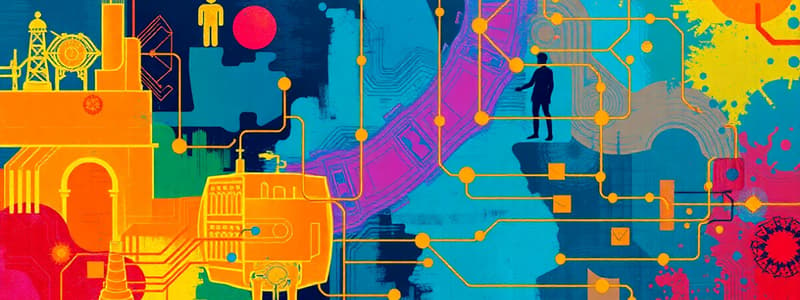Podcast
Questions and Answers
Which of the following is NOT a primary focus area of the Industrial Internet of Things (IIoT)?
Which of the following is NOT a primary focus area of the Industrial Internet of Things (IIoT)?
- Horizontal integration among supply networks
- Financial investment strategies (correct)
- Covering the product life cycle
- Vertical integration from machines to the cloud
IIoT systems are designed to completely halt operations if the connection to the cloud or enterprise level fails.
IIoT systems are designed to completely halt operations if the connection to the cloud or enterprise level fails.
False (B)
Name the three main layers in the architecture of an IIoT system.
Name the three main layers in the architecture of an IIoT system.
Edge, Plant, and Cloud/Enterprise
In IIoT architecture, the layer that monitors production equipment with sensors is called the ______ layer.
In IIoT architecture, the layer that monitors production equipment with sensors is called the ______ layer.
Match the IIoT layer with its primary function:
Match the IIoT layer with its primary function:
What is the primary function of gateways in an IIoT system?
What is the primary function of gateways in an IIoT system?
The Plant Service Bus is responsible for handling plant-level data while ensuring security and compliance with protocols.
The Plant Service Bus is responsible for handling plant-level data while ensuring security and compliance with protocols.
Give two examples of protocols used by edge devices to communicate within an IIoT system.
Give two examples of protocols used by edge devices to communicate within an IIoT system.
______ analytics involves processing data at the source (i.e., the edge) and sending commands back to the equipment without cloud intervention.
______ analytics involves processing data at the source (i.e., the edge) and sending commands back to the equipment without cloud intervention.
Which type of analytics involves using historical data to predict future equipment failures in an IIoT system?
Which type of analytics involves using historical data to predict future equipment failures in an IIoT system?
IIoT primarily focuses on improving marketing strategies rather than enhancing manufacturing processes.
IIoT primarily focuses on improving marketing strategies rather than enhancing manufacturing processes.
List two key challenges that IIoT aims to address in industrial settings.
List two key challenges that IIoT aims to address in industrial settings.
The ability of an IIoT system to easily adjust to new requirements or technologies is referred to as ______.
The ability of an IIoT system to easily adjust to new requirements or technologies is referred to as ______.
In an IIoT system, what ensures continuous operation, even when there are connectivity issues with the cloud?
In an IIoT system, what ensures continuous operation, even when there are connectivity issues with the cloud?
Threshold-based analytics in IIoT systems relies on complex predictive models to detect anomalies.
Threshold-based analytics in IIoT systems relies on complex predictive models to detect anomalies.
Match each component with its function inside the IIoT architecture:
Match each component with its function inside the IIoT architecture:
What distinguishes model-based analytics from threshold-based analytics in IIoT applications?
What distinguishes model-based analytics from threshold-based analytics in IIoT applications?
Describe the role of vertical integration in the context of the Industrial Internet of Things (IIoT).
Describe the role of vertical integration in the context of the Industrial Internet of Things (IIoT).
In the context of IIoT, the integration of various entities across the supply chain signifies ______ integration, enhancing collaboration and efficiency.
In the context of IIoT, the integration of various entities across the supply chain signifies ______ integration, enhancing collaboration and efficiency.
In an IIoT environment, edge devices communicate exclusively through standardized TCP/IP protocols to ensure universal compatibility.
In an IIoT environment, edge devices communicate exclusively through standardized TCP/IP protocols to ensure universal compatibility.
Flashcards
IIoT Focus
IIoT Focus
Vertically integrates machines to the cloud, horizontally integrates supply networks, and covers the product life cycle.
Key IIoT Challenges
Key IIoT Challenges
Higher throughput, preventing failures, ensuring flexible designs, and avoiding technology gaps.
IIoT Architecture Layers
IIoT Architecture Layers
Edge, Plant, and Cloud/Enterprise.
Edge Devices
Edge Devices
Signup and view all the flashcards
IIoT Gateways
IIoT Gateways
Signup and view all the flashcards
Edge Analytics
Edge Analytics
Signup and view all the flashcards
Plant Service Bus
Plant Service Bus
Signup and view all the flashcards
IIoT Analytics Types
IIoT Analytics Types
Signup and view all the flashcards
What can edge devices integrate with?
What can edge devices integrate with?
Signup and view all the flashcards
Common IIoT Communication Protocols
Common IIoT Communication Protocols
Signup and view all the flashcards
IIoT System Requirement
IIoT System Requirement
Signup and view all the flashcards
Study Notes
Industrial Internet of Things (IIoT) Focus Areas
- Vertically integrates systems, from machines to the cloud
- Horizontally integrates supply networks
- Covers the entire product life cycle
Key Challenges
- Increasing productivity through higher throughput and efficiency
- Preventing failures and maintaining high product quality
- Achieving flexible design for easy configuration and to avoid technology gaps
IIoT Architecture Layers
- Edge: Monitors production equipment using sensors (machines, robots, conveyors)
- Plant: Collects and processes data for analytics at the plant level
- Cloud/Enterprise: Conducts higher-level analytics and ensures continuous operation during connectivity problems
Key Components
- Edge Devices: Include sensors and are integrated with SCADA systems, communicating via protocols such as Profibus, OPC, and MQTT
- Gateways: Act as bridges between systems, enabling edge analytics, local data storage, and autonomy during connection failures
Data Flow
- Edge Analytics: Processes data at the edge and sends commands back to equipment
- Plant Service Bus: Manages plant-level data, ensuring security and protocol compliance
- Analytics: Uses threshold-based or model-based methods for predictive maintenance and quality control
Operational Importance
- IIoT systems must maintain factory operations, even if cloud or enterprise systems fail
Studying That Suits You
Use AI to generate personalized quizzes and flashcards to suit your learning preferences.




